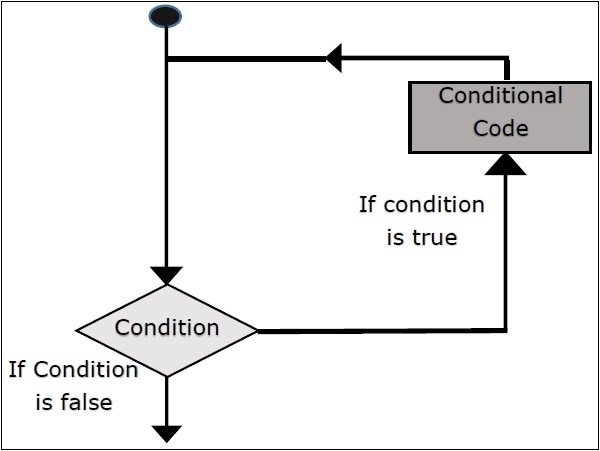This chapter takes you through the loop control structures in Scala programming languages.
There may be a situation, when you need to execute a block of code several number of times. In general, statements are executed sequentially: The first statement in a function is executed first, followed by the second, and so on.
Programming languages provide various control structures that allow for more complicated execution paths.
A loop statement allows us to execute a statement or group of statements multiple times and following is the general form of a loop statement in most of the programming languages −
 Scala programming language provides the following types of loops to
handle looping requirements. Click the following links in the table to
check their detail.
Scala programming language provides the following types of loops to
handle looping requirements. Click the following links in the table to
check their detail.
The following program implements infinite loop.
There may be a situation, when you need to execute a block of code several number of times. In general, statements are executed sequentially: The first statement in a function is executed first, followed by the second, and so on.
Programming languages provide various control structures that allow for more complicated execution paths.
A loop statement allows us to execute a statement or group of statements multiple times and following is the general form of a loop statement in most of the programming languages −
Flow Chart
 Scala programming language provides the following types of loops to
handle looping requirements. Click the following links in the table to
check their detail.
Scala programming language provides the following types of loops to
handle looping requirements. Click the following links in the table to
check their detail.| Sr.No | Loop Type & Description |
|---|---|
| 1 |
while loop Repeats a statement or group of statements while a given condition is true. It tests the condition before executing the loop body. |
| 2 |
do-while loop Like a while statement, except that it tests the condition at the end of the loop body. |
| 3 |
for loop Executes a sequence of statements multiple times and abbreviates the code that manages the loop variable. |
Loop Control Statements
Loop control statements change execution from its normal sequence. When execution leaves a scope, all automatic objects that were created in that scope are destroyed. As such Scala does not support break or continue statement like Java does but starting from Scala version 2.8, there is a way to break the loops. Click the following links to check the detail.| Sr.No | Control Statement & Description |
|---|---|
| 1 |
break statement Terminates the loop statement and transfers execution to the statement immediately following the loop. |
The infinite Loop
A loop becomes an infinite loop if a condition never becomes false. If you are using Scala, the while loop is the best way to implement infinite loop.The following program implements infinite loop.
Example
object Demo { def main(args: Array[String]) { var a = 10; // An infinite loop. while( true ){ println( "Value of a: " + a ); } } }Save the above program in Demo.scala. The following commands are used to compile and execute this program.
Command
\>scalac Demo.scala \>scala Demo
Output
If you will execute above code, it will go in infinite loop which you can terminate by pressing Ctrl + C keys.Value of a: 10 Value of a: 10 Value of a: 10 Value of a: 10 …………….

No comments:
Post a Comment